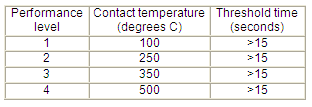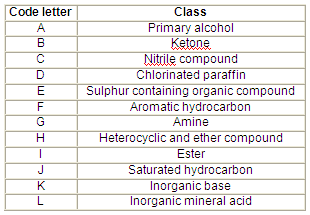
Standards
AS/NZS 2161:2008 is the standard that covers occupational protective gloves .This series of standards ensures the correct gloves are chosen and maintained to provide users with effective protection.
Public Sports & Workwear place a great amount of focus on quality and standards, promoting the need for gloves to be certified to AS/NZS 2161 standards. If the gloves are not certified they are manufactured to meet the requirements of the standards.
Public Sports & Workwear were the first to have our Big Red and Kevlar Blue welding gloves certified by Occupational Gloves for protection against thermal risks (heat and fire), AS/NZS 2161.3:2005 - Protection Against Mechanical Risks.
What are the Most Common Glove Standards?
AS/NZS 2161.3:2005 (EN388) Protection against mechanical risks
AS/NZS 2161.4:1999 (EN407) Protection against thermal risks (heat and fire)
AS/NZS 2161.5:1998 (EN511) Protection against cold
AS 2161.6-2003 Protective gloves for firefighters - Laboratory test methods and performance requirements
AS/NZS 2161.10.3:2005 (EN 374-3) Determination of resistance to permeation by chemicals
AS/NZS 2161.2:1998 (EN 420) General Requirements

|
1-This standard defines the general requirements for protective gloves in terms of construction, fitness of purpose, safety, etc 3-The highest permitted value for chromium is 3 mg/kg (chrome VI). |
This standard defines the general requirements and relevant test procedures for all protective gloves and is concerned with the following areas:
* glove design and construction, * resistance of gloves materials to water penetration,
* innocuousness,
* comfort and efficiency,
* marking and information supplied by the manufacturer.
AS/NZS 2161.3:2005 - Protection Against Mechanical Risks (EN388)

Mechanical risk is the risk caused by abrasion, blade cut, tear and puncture to the wearer of the glove. A tested item is given a performance rating of 1 to 4 (lowest to highest) on some or all of the listed categories. The blade cut resistance test is an exception as it measures from 1 to 5. Frequently an x will replace one or more of the numbers, this means that the corresponding test was not performed.
The performance values assigned against each test factor correspond approximately to the following values.

Abrasion resistance: How well can the material of the glove resist exposure to repeated abrasion.
Blade cut resistance: How well can the material of the glove resist cutting objects.
Tear resistance: What force is needed to enlarge, by tearing a precut hole in the material of the glove. Puncture resistance: What force is needed to puncture the palm of the glove with a calibrated spike.
AS/NZS 2161.4:1999 - Protection against thermal risks (heat and fire) EN407

This diagram details the testing categories for EN407: 2004. A tested item is given a performance rating of 1 to 4 (lowest to highest) on some or all of the listed categories. Frequently an x will replace one or more of the numbers, this means that the corresponding test was not performed.

The following table details the performance levels for the contact heat category:

AS/NZS 2161.5:1998 Protection against cold (EN511)
This diagram details the testing categories for BS EN511: 1994. A tested item is given a performance rating of 1 to 4 (lowest to highest) on some or all of the listed categories. Water Impermeability is an exception in this case, as this test is pass/fail - 1 signifies a pass. Frequently an x will replace one or more of the numbers, this means that the corresponding test was not performed.

AS 2161.6-2014 Protective gloves for firefighters. Laboratory test methods and performance requirements
This Standard specifies test methods and minimum requirements for protective gloves to be worn during fire fighting and associated activities where there is a risk of heat and/or flame. This standard supersedes (in part) AS 2161.6—2003.
This Standard is based on but not equivalent to ISO 15383:2001, Protective gloves for firefighters—Laboratory test methods and performance requirements.
The 2014 revision removed specifications for Type 1 gloves, a change reflected in the new part title of the Standard and to introduce a single level of performance for structural firefighting gloves in place of the previous two level approach (Types 2 and 3). Type 1 gloves will continue to be able to comply with AS 2161.6—2003 until it is withdrawn.
EN12477 Protective Gloves for Welders
The standard specifies the requirements and test methods for the gloves used for manual welding of metals, cutting and related techniques. The welders gloves are classified into two categories. B when a dexterity is required and A for others welding processes.
AS/NZS 2161.10.3:2005 (EN 374-3) Determination of resistance to permeation by chemicals
This pictogram is displayed on gloves that comply to penetration and permeation requirements. Gloves that carry this symbol have been successfully tested against at least 3 different chemicals. The pictogram is accompanied by the relevant code letter(s) of these chemicals according to the following chart

Leather
The leather glove is the oldest type of glove known to man. The most common leathers are cowhide, buffalo, goatskin, pigskin or lambskin. Leather can be used in two forms, grain leather the smooth outer side of a piece of leather offering suppleness and dexterity or split leather, the rougher inner side which is economical and has good abrasion resistance. Leather - More Information
Cotton
A natural fibre that is exceptionally subtle, soft and comfortable. Cotton also excels in absorbing perspiration and is breathable. It insulates well, making it ideal to use in heat resistant products.
Wool
A natural fibre which is subtle, soft and comfortable. Wool has excellent heat insulation and has natural flame resistance. Wool also provides good dexterity when used as a liner in conjuction with materials.
Polyester
A durable, synthetic fiber that is resistant to abrasion and tearing with low moisture absorbency that resists shrinkage during laundering.
Cotton/Polyester
Polyester, a synthetic fiber, is blended with natural cotton fibers to increase strength and offer basic abrasion resistance.
Nylon
Nylon is a synthetic, low linting, high tensile strength fiber that offers excellent dexterity and tactile sensitivity.
Acrylic
A synthetic fiber that helps provide insulation from cold temperatures and is quick drying.
Jersey
Knit fabric that stretches to provide an excellent form fit.
Canvas
Woven fabric with napped surface on one side.
DuPont KEVLAR
Manufactured by DuPont, KEVLAR is a lightweight para-aramid fibre with extraordinary strength and toughness. When used in Hand and Arm Protective products KEVLAR absorbs energy, resists cuts and abrasion. What�s more KEVLAR provides exceptionally long wear life, heat resistance and dexterity for intricate jobs. Weight for weight, KEVLAR is five times stronger than steel and provides a cut resistance up to five times higher than that of leather
Twaron
Twaron is a very strong, light para-aramid fiber (poly-paraphenylene terephthalamide) developed and produced exclusively by Teijin Aramid. It has a high modulus, and is thermally stable, and highly impact and chemical resistant.
Dyneema
Dyneema is a high-performance polyethylene (HPPE) fibre produced using a patented gel spinning process that offers maximum strength combined with minimum weight and 15 times stronger than steel. Dyneema is highly resistant to water, sweat, odours and chemicals, providing a longer operational life for the finished product. Elliott Australia does not use Dyneema.
Dynamax
Dynamax is also a high-performance polyethylene (HPPE) fibre that offers maximum strength combined with minimum weight. Dynamax is highly flexible, comfortable and strong fibre.
Spectra
Spectra fibre is one of the world�s strongest and lightest fibres. A bright white fibre that is, weight-for-weight, 10 times stronger than steel, more durable than polyester and has a specific strength that is 40 per cent greater than aramid fibre. Spectra fibre is made from ultra-high molecular weight polyethylene that is produced in a patented gel-spinning process. Light enough to float, Spectra fibre exhibits high resistance to chemicals, water and UV light, it also has excellent vibration damping and flex-fatigue